Location
Ajanta Caves in Aurangabad District, Maharashtra are approximately 200 miles away from the hustle and bustle of the crowded streets of Mumbai. Tucked away in the hills of Northwest India lies this ancient masterpiece which can be considered as the jewelled crown of art with a mix of religion showcasing detailed ancient art.
About The Ajanta Cave Paintings
Buddhist Cave monuments
The Ajanta caves consists of 30 rock-cut Buddhist cave monuments dating from 2nd century to 480 CE. It has rock-cut sculptures and paintings that are considered to be the finest surviving examples of Ancient Indian Art.
Recommended Story – Cave Paintings In India
What Do Ajanta Cave paintings depict
These are expressive paintings that present the emotions through gestures, pose and form. They depict scenes from Jataka Tales and showcase the life examples and sacrifices made by Buddha in his past incarnations. According to UNESCO, these Buddhist religious art form has had a strong influence on Indian Art.
Mural Paintings
These caves were built in two phases, the first group of caves were built around the 2nd century BC and the second group of caves were built around 450-600 AD according to Walter M. Spink.
We can find Mural paintings from both these eras. Several fragments of murals which have been preserved from the earlier built caves (Caves 9 and 11) are comparatively unique and are the survivors of the ancient painting in India from that very period.

These paintings showcase how Indian painters had mastered a naturalistic style that was so fluent which is evident from the murals.
Recommended Story – Tanjore Paintings : Classical South Indian Painting
There are two stylistic groups in which these paintings fall, with the most famous being in Cave 16 and 17 and later in Caves 1 and 2.
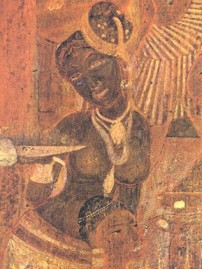
Where Cave 1 presented the paintings which had emphasis on kingship, Cave 2 on the other hand showed noble and powerful women in prominent roles.

Source: openart.in
The Ajanta frescos are a representation of the classical paintings made by confident artists who gave birth to this art that is rich, vibrant and without any clichés.
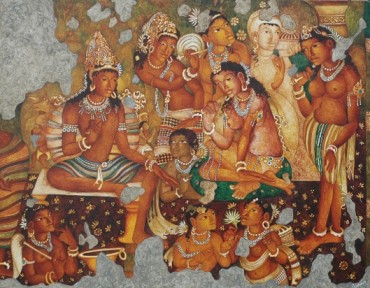
Source: openart.in
Celebrating the physical beauty, there are luxurious and sensuous aspects which were literally shocking for the early western observers who presumed that these were meant for religious worship and ascetic monastic life.
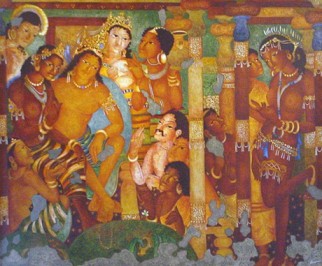
Source: openart.in
Imported from Northern India, Central Asia and Persia the colours used in these paintings were mainly red ochre, yellow ochre, lamp black, white and lapis lazuli. The green colour used was made from the mixture of lapis lazuli with Indian yellow ochre.

Source: openart.in
The pictorial cycles had characters which are bright and have the concept of multi-colour but are not repetitive, a fundamental concept in Indian Art.

Source: openart.in
The ceilings and walls are all covered with overlapping figures which has been brought to life by the artists by filling each inch of the Ajanta cave painting with strong, bright and contrasting colours. You can strike a similarity between the painting techniques at Ajanta being similar to European fresco technique.
The only difference being the layer of plaster was dry when it was painted. First, a rough plaster of clay, cow dung and rice husks were pressed on the rough cave walls which was then coated with lime juice which helped in creating a smooth working surface.

Alavokitesvara
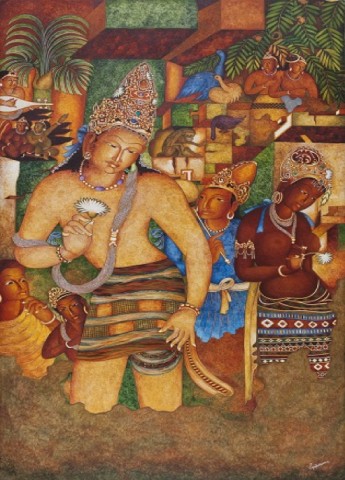
Source: indiaart.com
The painting of ‘Alavokitesvara’ depicts one of the most beloved ‘Bodhisattva’ basically referring to a person who has been awakened by the Buddhist spirit.
According to Mahayana doctrine, Alavokitesvara postponed his ascension into Buddhahood until he assisted every being in achieving Nirvana. Alavokitesvara takes the largest numbers of forms across Asia. Originally recognized as masculine it is known to be feminine Guanyin in China and Kuan Yin in Japan.
Recommended Story – Madhubani Paintings
In the painting, he has been majestically presented, his tan body which is further darkened due to the black locks of his curly hair soothes your eyes because of its delicate and elegant nature.
He is adorned with traditional Indian jewelleries along with pearls and amethyst. A magnificent crown is placed on his head which was bright oozing with intricate details due to the colours but now has faded over the period of time.
His eyes are in a meditative state perfectly placed on his calm, spiritual face which awakens the surroundings and seems to look like the painting is conveying an emotion that only your soul can understand. In his right hand, he holds a lotus blossom which may be representing his spiritual awakening.
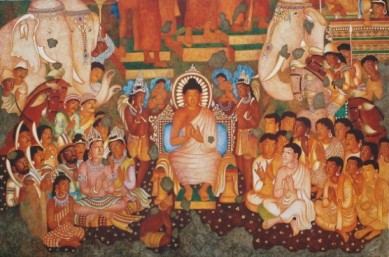
Source: indiaart.com
Also Read – Rajput Painting









